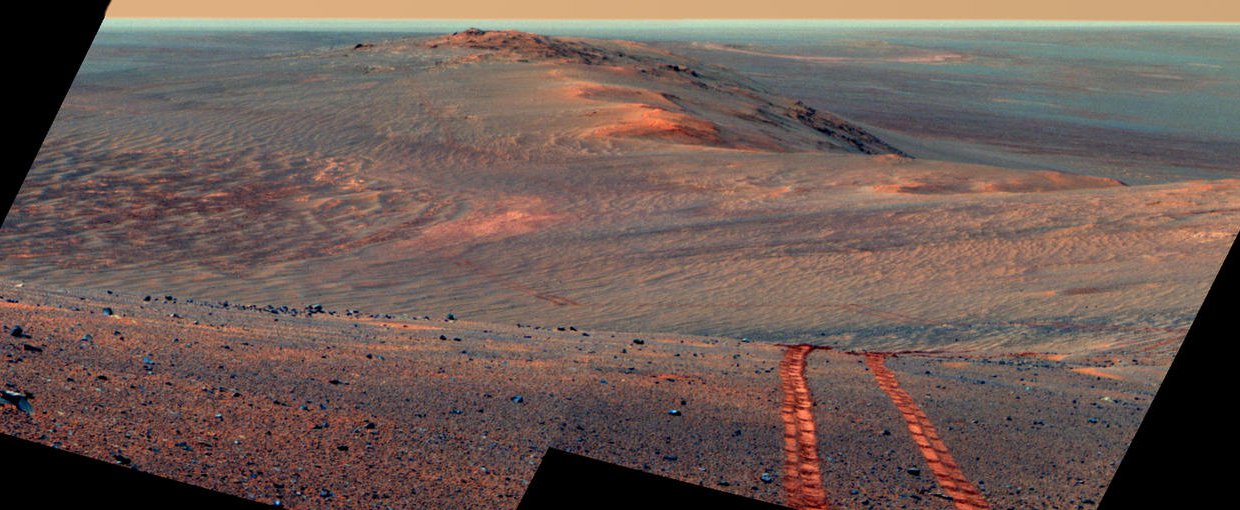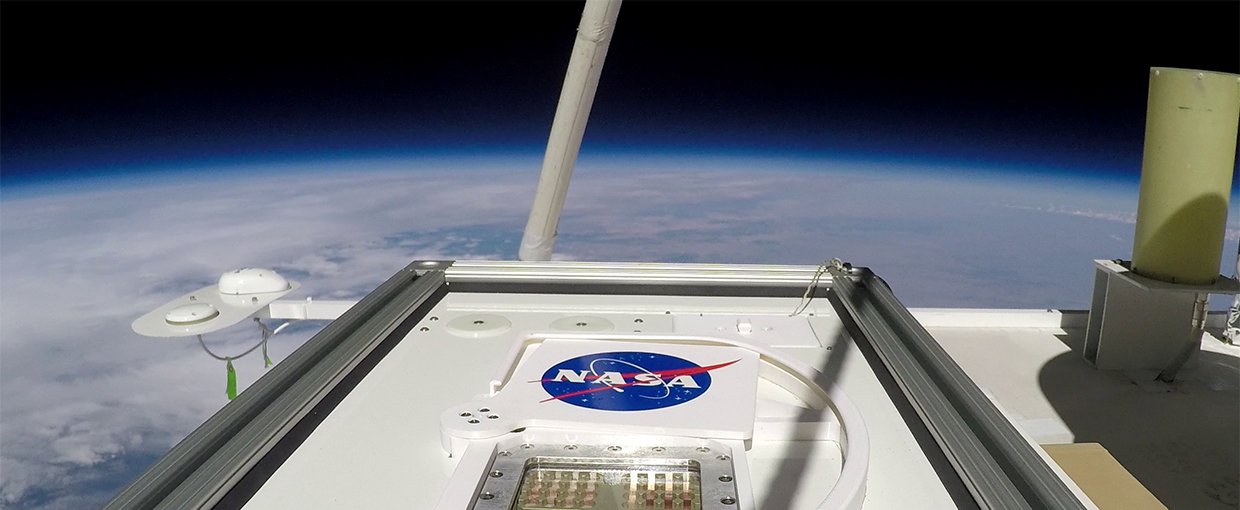
A recent study supported by the NASA Planetary Protection Research Program is lending new insight into hypopiezotolerant microorganisms.
“The term ‘hypopiezotolerant’ means a microbe that is tolerant of low-pressure,” explains Dr. Andrew Schuerger, a researcher at the University of Florida and Principal Investigator (PI) on the NASA grant. “Hypo means low and piezo means pressure.”
The term ‘tolerant’ means a microbe that can tolerate low-pressures, but in which a low-pressure environment is not their normal ecological niche. As their name indicates, these organisms are adapted to grow at low atmospheric pressures. This ability could be invaluable for astrobiologists who are trying to determine if and how life as we know it might proliferate on Mars. The term hypopiezotolerant was coined in a previous study by authors Dr. Shuerger and Dr. Petra Schwendner, a postdoctoral researcher in Shuerger’s lab.

A view from the "Kimberley" formation on Mars taken by NASA's Curiosity rover. The pressure at Mars' surface is far less than the pressure experienced at the surface of the Earth.Image credit: NASA/JPL-Caltech/MSSS.
The atmosphere of Mars is far less dense than the atmosphere of Earth, and low atmospheric pressure is one of the most prominent environmental stresses that life on Mars would have to cope with. Some hypopiezotolerant bacteria on Earth are capable of reproducing and thriving at atmospheric pressures similar to those found on Mars (7 to 12 millibar (mbar)), and the mechanisms they use to live could help astrobiologists understand the potential habitability of the martian environment. Shuerger and his team also published a review of recent studies on this topic earlier this year. In addition to teaching astrobiologists about the habitability of the red planet, hypopiezotolerant organisms can also help scientists better understand issues regarding planetary protection for future Mars missions.
Microorganisms from Earth that can thrive in martian atmospheric pressures might pose a problem in terms of the forward contamination of Mars. As the Mars 2020 mission’s Perseverance rover heads to the red planet to study habitability and look for organic molecules, it is vital to ensure that microorganisms from Earth do not hitch along for the ride. If mission components were contaminated with organisms that could survive and proliferate on Mars, they could be misidentified as signs of life on the red planet. And if there is extant biology on Mars today, Earth microbes could disrupt a fragile ecosystem before astrobiologists have a chance to identify and study it.

A United Launch Alliance Atlas V rocket with NASA’s Mars 2020 Perseverance rover onboard launches from Space Launch Complex 41, Thursday, July 30, 2020, at Cape Canaveral Air Force Station in Florida.Image credit: NASA/Joel Kowsky.
Low Pressure on Earth
The trick to understanding life’s ability to adapt to low pressure is to study examples of organisms on Earth that have evolved this capability.
“Low-pressure tolerant bacteria are essential to studying the potential life on Mars because all of the martian surface is in the range of 2-12 mbar,” said Schuerger. “Earth sea-level pressure is at 1013 mbar. Thus, the martian surface is < 1.2% of Earth’s sea level pressure.”
However, pressure decreases as you rise higher in the atmosphere. Here on Earth, the ability to survive at low atmospheric pressure is an important adaptation for microbes that are lofted into the clouds or transported on the wind. It is difficult to study these organisms because the environment isn’t easy for scientists to access and, even when you do bring instruments into the stratosphere, the microbes are found in such low densities that they are hard to collect and identify.
“To achieve the same pressure as Mars on Earth, one would have to send an experiment into the middle stratosphere on a sounding rocket,” explains Shuerger. “The top of Mt. Everest is at 330 mbar, still much higher than the surface pressure on Mars.”
Despite the challenges, NASA has invested in research to understand the role of microorganisms in the atmosphere, a field referred to as aerobiology. In 2014 NASA undertook the E-MIST 1 (Exposing Microorganisms in the Stratosphere 1) experiment to test hardware and procedures for studying microorganisms in Earth’s stratosphere. More recently in 2019, NASA sent nine different types of microorganisms into the stratosphere on a scientific balloon. MARSBOx (Microbes in Atmosphere for Radiation, Survival and Biological Outcomes Experiment) was released from Fort Sumner, New Mexico, on Sept. 23, 2019, and spent 6.5 hours aloft to reach a sustained altitude of 110,000 feet. While in the air, the microorganisms were exposed to extreme environmental conditions present in the stratosphere including reduced pressure, cold temperatures, dryness, and elevated ultraviolet radiation.

Hardware carrying the second Exposing Microorganisms in the Stratosphere experiment is seen floating 19 miles above the Earth aboard a NASA scientific balloon.Image credit: NASA.
Earth Microbes and Mars
Rather than using balloons, Dr. Schuerger and colleagues simulate conditions at the martian surface by performing experiments in a Mars chamber in the lab. This chamber is able to produce a controlled environment with low pressure and temperature, exposing samples to stresses similar to those found on the martian surface.
Most of the previous studies on hypopiezotolerant organisms have been performed in liquid- or agar-based media in the laboratory. The new study takes this a step further, testing whether or not microorganisms can grow in Mars analog soils under low pressure. Mars soils under low pressure pose extra challenges for organisms due to desiccation (extreme dryness) of the soil.
In the new study, researchers focused on the microorganism Serratia liquefaciens, which can grow at 7 mbar and tolerates both desiccation and moderate levels of salt. Importantly, species of Serratia have been found on spacecraft hardware in clean rooms and could be one of the types of organisms that future missions need to be extra careful about when sending robotic or human explorers to Mars.
Such concerns over planetary protection in missions were on display this summer with the launch of the Perseverance rover. Now en route to Mars, Perseverance will land in February of 2021 and, among its many objectives, will study the habitability of Mars and hunt for signatures of ancient life on the red planet. Great care was taken to sanitize the rover before launch, and also to document the microorganisms present on mission components. This is another focus of research at NASA’s Planetary Protection Program, which supports the work of Parag Vaishampayan of the Biotechnology and Planetary Protection Group (BPPG) at the NASA Jet Propulsion Laboratory (NASAJPL). Vaishampayan performs taxonomic identification of all the bacterial isolates (~6000) associated with previous NASA missions and uses the data to construct a Genome Encyclopedia of Spacecraft Associated Microorganisms (GESAM).
Countdown to Mars! with Dr. Parag VaishampayanImage credit: Mike Toillion / NASA Astrobiology.
“Results of the GESAM project will allow researchers to select more appropriate bacterial candidates for further laboratory simulation experiments,” commented Dr. Vaishampayan. “I am happy to see how different PPR funded projects can complement each other”.
With support from the Mars 2020 project and the Mars Program Office at JPL, Dr. Vaishampayan is also creating a genetic inventory of the entire Mars 2020 spacecraft. This data will be critical in ensuring that Earth microbes do not interfere with the Perseverance rover’s astrobiology investigations at Mars.
Studies on the entire microbial load present on mission components are important in identifying particular organisms that could pose problems for astrobiology experiments. When such organisms are identified, they can then become the focus of more detailed studies like tbose performed by Shuerger’s team.
“To date, we have reported on 30 bacteria that can grow at 7-10 mbar of total pressure while also incubated at 0°C and in a CO2-anoxic atmosphere (similar to the surface of Mars),” explains Schuerger. “It turns out that almost all of these hypopiezotolerant bacteria occur primarily in Arctic soil or permafrost. Serratia liquefaciens was selected because members of this genus are regularly recovered from spacecraft surfaces, and thus, are plausible “hitchhiking” contaminants that might go to Mars on a spacecraft.”
The researchers mixed cells of S. liqeufaciens into a wide range of Mars analog soils, and then supplemented the soils with water and nutrients to simulate a habitable environment. The results brought some positive news for future mission planners. The team found that all four soils tested had varying levels of biocidal activity, meaning that S. liqeufaciens was unable to grow. In soils with high salt content, cells were completely inactive after seven days. For soils that simulate the study site of NASA’s Phoenix lander, the density of cells decreased over 28 days. Based on previous work, the team believes that the low density of cells is indicative of cell death.

Dr. Andrew Schuerger of the University of Florida with the Mars chamber used to simulate conditions at the surface of Mars.Image credit: University of Florida.
Although S. liquefaciens has previously been shown to grow in low pressure conditions on agar-based media, the new study added additional environmental stresses to more accurately simulate the martian surface, including pH, colder temperatures, and the presence of multiple salts. It is possible that the combination of extreme conditions on Mars could prove too much for Earth-organisms, even when those organisms are adapted to survive and grow in low pressure environments. The study was focused on a single organism, and the team of researchers will expand this work to cover a broader range of hypopiezotolerant microorganisms.
“Future research will expand into using Arctic permafrost and soil bacteria because not only do they grow at 7 mbar, they are much more cold-hardy than S. liquefaciens,” says Schuerger.
In the new study, the team provides a list of suggestions for future experiments on microbial growth in Mars conditions, including explanations of the ideal pressure ranges, selection of microorganisms, nutrient regimes, and a discussion of the microbial activity that could be considered ‘positive growth’ in experiments. These suggestions could help to provide consistent protocols for future work related to issues of planetary protection on Mars.
With the launch of NASA’s newest effort to explore the red planet, the Mars 2020 mission and its Perseverance rover, understanding the potential habitability of Mars has never been more important. Perseverance will examine the geology of its landing site in Jezero crater to provide more information about habitable environments in Mars’ past and will even search for possible biosignatures of ancient life. Importantly, the rover will also collect a cache of samples that will be retrieved by a future Mars Sample Return mission and returned to Earth for study. Studying the survivability of organisms like S. liquefaciens in Mars-like conditions is essential in mitigating the risk of forward contamination of Mars. This is not only to protect possible martian life, but also to make sure samples collected on Mars are not contaminated with life from Earth.
Related:
NASA’s E-MIST Experiment Soars in Earth’s Atmosphere (NASA 2014)
Microbes Could Survive Thin Air of Mars
How Stratospheric Life is Teaching us about the Possibility of Extreme Life on Other Worlds
Publications:
Schuerger, AC, Mickol, RL, Schwendner, P. (2020) “The Hypopiezotolerant Bacterium, Serratia liquefaciens, Failed to Grow in Mars Analog Soils under Simulated Martian Conditions at 7 hPa,” Life, 10(6), 77.
Schwendner, P, Schuerger AC. (2020) “Exploring microbial activity in low-pressure environments,” Current Issues in Molecular Biology, 38, 163-196.


